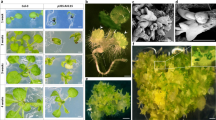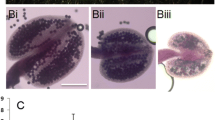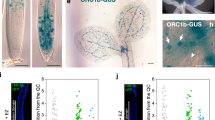Abstract
In animals and plants, many cell types switch from mitotic cycles to endoreduplication cycles during differentiation. Little is known about the way in which the number of endoreduplication cycles is controlled in such endopolyploid cells. In this study we have characterized at the molecular level three mutations in the Arabidopsis gene KAKTUS ( KAK), which were previously shown specifically to repress endoreduplication in trichomes. We show that KAK is also involved in the regulation of the number of endoreduplication cycles in various organs that are devoid of trichomes. KAK encodes a protein with sequence similarity to HECT domain proteins. As this class of proteins is known to be involved in ubiquitin-mediated protein degradation, our finding suggests that the number of endoreduplication cycles that occur in several cell types is controlled by this pathway. The KAK gene defines a monophylogenetic subgroup of HECT proteins that also contain Armadillo-like repeats.






Similar content being viewed by others
References
Andrade M, Petosa C, O’Donoghue S, Muller C, Bork P (2001) Comparison of ARM and HEAT protein repeats. J Mol Biol 309:1–18
Bates PW, Vierstra RD (1999) UPL1 and 2, two 405 kDa ubiquitin-protein ligases from Arabidopsis. Plant J 20:183–195
Blanc G, Barakat A, Guyot R, Cooke R, Delseny M (2000) Extensive duplication and reshuffling in the Arabidopsis genome. Plant Cell 12:1093–1102
Bouchez D, Vittorioso P, Courtial B, Camilleri C (1996) Kanamycin rescue: a simple technique for the recovery of T-DNA flanking sequences. Plant Mol Biol Rep 14:115–123
Clough SJ, Bent AF (1998) Floral dip: a simplified method for Agrobacterium -mediated transformation of Arabidopsis thaliana. Plant J 16:735–743
Conti E, Uy M, Leighton L, Blobel G, Kuriyan J (1998) Crystallographic analysis of the recognition of a nuclear localization signal by the nuclear import factor karyopherin alpha. Cell 94:193–204
Galbraith DW, Harkins KR, Knapp S (1991) Systemic endopolyploidy in Arabidopsis thaliana. Plant Physiol 96:985–989
Gendreau E, Traas J, Desnos T, Grandjean O, Caboche M, Höfte H (1997) Cellular basis of hypocotyl growth in Arabidopsis thaliana. Plant Physiol 14:295–305
Gendreau E, Orbovic V, Hofte H, Traas J (1999) Gibberellin and ethylene control endoreduplication levels in the Arabidopsis thaliana hypocotyl. Planta 209:513–516
Görlich D (1998) Transport into and out of the cell nucleus. EMBO J 17:2721–2727
Hochstrasser M (1996) Ubiquitin-dependent protein degradation. Annu Rev Genet 30:405–439
Huang L, Kinnucan E, Wang G, Beaudenon S, Howley P, Huibregtse J, Pavletich N (1999) Structure of an E6AP-UbcH7 complex: insights into ubiquitination by the E2-E3 enzyme cascade. Science 286:1321–1326
Huibregtse JM, Scheffner M, Beaudenon S, Howley PM (1995) A family of proteins structurally and functionally related to the E6-AP ubiquitin-protein ligase. Proc Natl Acad Sci USA 92:2563–2567
Hülskamp M, Misera S, Jurgens G (1994) Genetic dissection of trichome cell development in Arabidopsis. Cell 76:555-566
Jacobsen SE, Olszewski NE (1993) Mutations at the SPINDLY locus of Arabidopsis alter gibberellin signal transduction. Plant Cell 5:887–896
Jacobsen SE, Binkowski KA, Olszewski NE (1996) SPINDLY, a tetratricopeptide repeat protein involved in gibberellin signal transduction in Arabidopsis. Proc Natl Acad Sci USA 93:9292–9296
Johnson ES, Ma PC, Ota IM, Varshavsky A (1995) A proteolytic pathway that recognizes ubiquitin as a degradation signal. J Biol Chem 270:17442–17456
Kirik V, Bouyer D, Schobinger U, Bechtold N, Herzog M, Bonneville J-M, Hülskamp M (2001) CPR5 is involved in cell proliferation and cell death control and encodes a novel transmembrane protein. Curr Biol 11:1891–1895
Kobe B (1999) Autoinhibition by an internal nuclear localization signal revealed by the crystal structure of mammalian importin alpha. Nat Struct Biol 6:388–397
Kumar S, Kao WH, Howley PM (1997) Physical interaction between specific E2 and Hect E3 enzymes determines functional cooperativity. J Biol Chem 272:13548–13554
Kwon YT, Reiss Y, Fried VA, Hershko A, Yoon JK, Gonda DK, Sangan P, Copeland NG, Jenkins NA, Varshavsky A (1998) The mouse and human genes encoding the recognition component of the N-end rule pathway. Proc Natl Acad Sci USA 95:7898–7903
Li J, Chory J (1997) A putative leucine-rich repeat receptor kinase involved in brassinosteroid signal transduction. Cell 90:929–938
McCallum CM, Comai L, Greene EA, Henikoff S (2000) Targeting induced local lesions in genomes (TILLING) for plant functional genomics. Plant Physiol 123:439–442
Nefsky B, Beach D (1996) Pub1 acts as an E6-AP-like protein ubiquitiin ligase in the degradation of Cdc25. EMBO J 15:1301–1312
Olszewski NE, Martin FB, Ausubel FM (1988) Specialized binary vector for plant transformation: expression of the Arabidopsis thaliana AHAS gene in Nicotiana tabacum. Nucleic Acids Res 16:10765–10782
Payne CT, Zhang F, Lloyd AM (2000) GL3 encodes a bHLH protein that regulates trichome development in arabidopsis through interaction with GL1 and TTG1. Genetics 156:1349–1362
Peifer M (1996) Regulating cell proliferation: as easy as APC. Science 272:974–975
Perazza D, Vachon G, Herzog M (1998) Gibberellins promote trichome formation by up-regulating GLABROUS1 in Arabidopsis. Plant Physiol 117:375–383
Perazza D, Herzog M, Hülskamp M, Brown S, Dorne AM, Bonneville J-M (1999) Trichome cell growth in Arabidopsis thaliana can be derepressed by mutations in at least five genes. Genetics 152:461–476
Pickart CM (2001) Mechanisms underlyling ubiquitination. Annu Rev Biochem 70:503–533
Rhoads AR, Friedberg F (1997) Sequence motifs for calmodulin recognition. FASEB J 11:331–340
Rotin D (1998) WW (WWP) domains: from structure to function. Curr Top Microbiol Immunol 228:115–133
Scheffner M, Nuber U, Huibregtse JM (1995) Protein ubiquitination involving an E1-E2-E3 enzyme ubiquitin thioester cascade. Nature 373:81–83
Schellmann S, Schnittger A, Kirik V, Wada T, Okada K, Beermann A, Thumfahrt J, Jürgens G, Hülskamp M (2002) TRIPTYCHON and CAPRICE mediate lateral inhibition during trichome and root hair patterning in Arabidopsis. EMBO J 21:5036–5046
Schnittger A, Schobinger U, Bouyer D, Weinl C, Stierhof Y-D, Hülskamp M (2002a) Ectopic D-type cyclin expression induces not only DNA replication but also cell division in Arabidopsis trichomes. Proc Natl Acad Sci USA 99:6410–6415
Schnittger A, Schobinger U, Stierhof Y-D, Hülskamp M (2002b) Ectopic B-type cyclin expression induces mitotic cycles in endoreduplicating Arabidopsis trichomes. Curr Biol 12:415–420.
Schnittger A, Weinl C, Bouyer D, Schobinger U, Hülskamp M (2003) Misexpression of the cyclin-dependent kinase inhibitor ICK1/KRP1 in single-celled Arabidopsis trichomes reduces endoreduplication and cell size and induces cell death. Plant Cell 15:303–315
Sugimoto-Shirasu K, Stacey NJ, Corsar J, Roberts K, McCann MC (2002) DNA topoisomerase VI is essential for endoreduplication in Arabidopsis. Curr Biol 12:1782–1786
Szymanski DB, Lloyd AM, Marks MD (2000) Progress in the molecular genetic analysis of trichome initiation and morphogenesis in Arabidopsis. Trends Plant Sci 5:214–219
Tamai KK, Shimoda C (2002) The novel HECT-type ubiquitin-protein ligase Pub2p shares partially overlapping function with Pub1p in Schizosaccharomyces pombe. J Cell Sci 115:1847–1857
Thornton TM, Kreppel L, Hart G, Olszewski N (1999) Genetic and biochemical analysis of Arabidopsis SPY. In: Altman A, Ziv M, Izhar S (eds) Plant biotechnology and in vitro biology in the 21st century. Kluwer Academic Publishers, Dordrecht, pp 445–448
Traas J, Hülskamp M, Gendreau E, Höfte H (1998) Endoreduplication and development: rule without dividing? Curr Opin Plant Biol 1:498–503
Vierstra RD, Callis J (1999) Polypeptide tags, ubiquitous modifiers for plant protein regulation. Plant Mol Biol 41:435–442
Walker JD, Oppenheimer DG, Concienne J, Larkin JC (2000) SIAMESE, a gene controlling the endoreduplication cell cycle in Arabidopsis thaliana trichomes. Development 127:3931–3940
Xie Y, Varshavsky A (2002) UFD4 lacking the proteasome-binding region catalyses ubiquitination but is impaired in proteolysis. Nat Cell Biol 4:1003–1007
You J, Pickart CM (2001) A HECT domain E3 enzyme assembles novel polyubiquitin chains. J Biol Chem 276:19871–19878
Acknowledgments
A.E.R. was the recipient of a fellowship from the Egyptian government. We are indebted to Renaud Blervaque for his help in the kanamycin rescue experiment, to Heda Dolezelova for left border cloning, and to Olivier Catrice for assistance with flow cytometry. We are indebted to the Kazusa DNA Research Institute and to N. Olszewski for plasmids. We also thank Anne Imberty for discussions on protein structures, and Gilles Vachon and Ali Hakimi for critical reading of the manuscript. The experiments described here have been carried out in compliance with French laws governing genetic experimentation
Author information
Authors and Affiliations
Corresponding author
Additional information
Communicated by G. Jürgens
Rights and permissions
About this article
Cite this article
El Refy, A., Perazza, D., Zekraoui, L. et al. The Arabidopsis KAKTUS gene encodes a HECT protein and controls the number of endoreduplication cycles. Mol Genet Genomics 270, 403–414 (2004). https://doi.org/10.1007/s00438-003-0932-1
Received:
Accepted:
Published:
Issue Date:
DOI: https://doi.org/10.1007/s00438-003-0932-1




